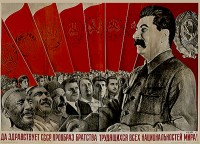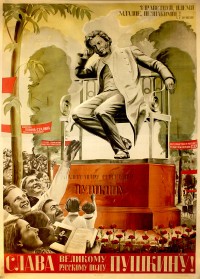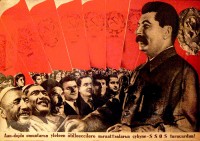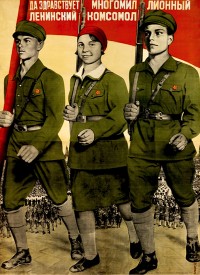Klutsis, Gustav Gustavovich (Klucis, Gustavs)
Born 1895, Vidzeme region, Russian Empire; died c. 1938-1944, State Labor Camp, USSR
Gustav Klutsis is considered the foremost artist of Soviet photomontage. Born near the small town of Ruiena, Latvia, (when Lativa was part of the Russian Empire), Klutsis attended the State Art School in Riga from 1913 to 1915 and then moved to Petrograd (St. Petersburg) during immediately prior to the October Revolution. Klutsis took part in a volunteer rifle regiment that helped overturn the Tsarist regime during the revolution. After the revolution, he continued his studies in Petrograd at OPKh (Imperial Society for the Encouragement of the Arts).
In 1918, Klutsis was sent to Moscow to serve as a guard in the Kremlin. That same year, he participated in the exhibition of art by members of the workshop of the Ninth Guard's Regiment. While in Moscow, he enrolled in Ilya Mashkov's studio for further artistic study. From 1919 to 1920, Klutsis attended the Free State Art Studios (SVOMAS) that later became VKhUTEMAS (Higher Art and Technical Studios) while he was enrolled. Credited as the birthplace of Soviet Constructivism, at VKhUTEMAS he experimented with photomontage design-- an element that would greatly influence his later work. In 1920, the artist became a member of the Communist Party.
In 1921, Klutsis married his artistic colleague, Valentina Kulagina. The couple had a son. Kulagina had been enrolled in SVOMAS/ VKhUTEMAS and she obtained a solid background in graphic design. While achieving success through collaboration with her husband, after his death, in her own right Kulagina was an important poster artist and designer.
By the mid-1920s, Klutsis was a well-known artist in the Soviet Union. Notoriety likely helped him to acquire a teaching position from 1924 to 1930 in the Woodwork and Metalwork Department of VKhUTEMAS. In 1925, he organized the artwork for the Soviet Pavilion for the International Exhibition of Modern Decorative and Industrial Arts in Paris. Between 1922 to 1925, he actively contributed designs to leading Soviet art magazines such as LEF, October, and Izofront. From 1928 to 1932, he was a member of the Oktiabr' (October) artists group, and from 1929 to 1932, a presiding member of the Artists of Revolutionary Posters.
By the early 1930s, Klutsis had become the foremost artist in the field of photomontage posters. His quality and output could only be rivaled by Lazar “El” Lissitzky and Alexandr Rodchenko, two contemporary artists working during the same period in the Soviet Union.
Soviet officials accused Gutav Klutsis of being a member of a counter-revolutionary, Latvian fascist organization. He was subsequently arrested in January 1938. An official report of his arrest was not given to the family until 1989, and the family learned of his death only in 1956 when information was released to them by the authorities. Reportedly, Klutsis died in 1944 while in a Soviet labor camp. Alternatively, published sources from post-Soviet Russia place the year of his death as 1938.
Fuentes
Dickerman, L. (2006, Autumn). The Fact and Photograph. October, 118, 132-152. (Photography in the USSR)
Tupitsyn, M. (2004). Gustav Klutsis and Valentina Kulagina: Photography and montage after constructivism. Gottingen: Steidl. (Book on the life and work of Klutsis and Kulagina)
Groys, B., & Hollein, M. (2003). Dream factory Communism: The visual culture of the Stalin era. Ostfildern-Ruit: Hatje Cantz. (bio, Klutsis)
Dickerman, L. (1996). Building the collective: Soviet graphic design, 1917-1937: selections from the Merrill C. Berman collection. New York: Princeton Architectural Press. (bio on the artist along with several illustrations of his work)
Milner, J. (1993). A dictionary of Russian and Soviet artists 1420-1970. Woodbridge: Antique Collectors' Club. (bio, Klutsis)
Bown, M. C. (1991). Art under Stalin. Oxford: Holmes & Meier. (OPKh, cited)
Baburina, N. I. (1988). The Soviet Political Poster, 1917-1980. New York: Penguin. (bio, artist)
![PP 059: [Stalin escribió] “¡La victoria del socialismo conquista nuestro país! La base de la economía socialista está consolidada.” [Traducción parcial]](https://www.posterplakat.com/thumbs/the-collection/posters/pp-059/pp059-200x300.jpg)
![PP 267: Un saludo a Dnieprostroi, la estación hidroeléctrica más grande del mundo, que ha comenzado a funcionar. ¡Viva por los trabajadores más productivos de la construcción del socialismo!
DGES [Estación Hidroeléctrica de Dnieper-Petrovsk]](https://www.posterplakat.com/thumbs/the-collection/posters/pp-267/pp267-200x278.jpg)

![PP 452: La realidad de nuestro programa es la gente real.
Somos nosotros los que estamos contigo. – Stalin
[Traducción parcial]](https://www.posterplakat.com/thumbs/the-collection/posters/pp-452/pp452-200x282.jpg)


